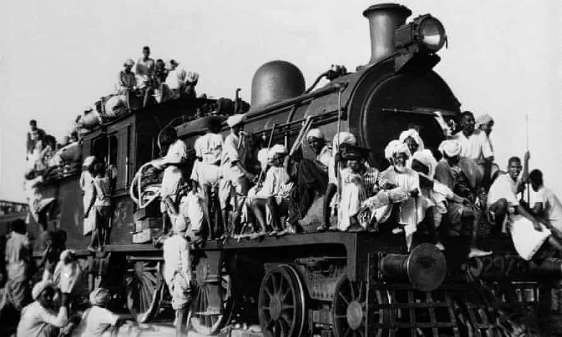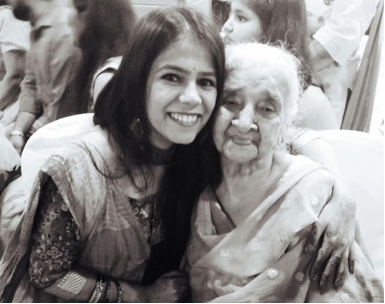My name is Ishankaur Khalsa - my very surname is a reminder of the village of Thoa Khalsa in pre-partitioned India where 90 women chose to jump in wells to save their honour — a choice that made them complicit in the violence against their bodies. Violence they chose as their fate as opposed to living their lives as women who were raped by people from the 'other' religion. It is Butalia’s work that paints a vivid picture of this carnage from a survivor’s memory who narrates “It’s like when you put rotis into a tandoor, and if it is too full, the one’s near the top, they don’t cook, they have to be taken out” — making the violence and mass killings during the partition of India-Pakistan one of the greatest human tragedies in South Asia.
Belonging from a family of Sikh refugees, these stories of migration, and the horrors of the time were handed down to me as a little girl. I’ve felt the sorrow in the voice of my grandmother when she spoke of her childhood home, and how people from the same country, and town were divided by the politics of religious differences. Walking behind carts, in caravans, whole villages migrating to what was going to be their new home, filled in trains and buses as if they were herding animals, standing, stepping on each other’s feet, wanting to reach Hindustan in whatever condition possible.
This simple, remorseless political geography infuses and divides us still, and this blog, therefore, comes as a political and personal engagement with a historical religious conflict, from my standpoint as a minority woman, who has heard these stories often in silence.
It is an attempt to give life to the silent stories that remain alive in me somewhere, long after my grandmother’s passing, through the phenomenal works of Urvashi Butalia, Kamla Bhasin, Amrita Pritam, Sadat Hasan Manto and Veena Das. It is a gendered telling of violence that distinguishes the dominant narratives recounted by men from those by women, where silences can be as revealing, if not more than spoken words.[6]
During the Partition, many women were abducted, raped, sold into prostitution, and forced into marriage. They were distributed like how baskets of oranges or grapes are sold or gifted.[7] While some were sold in the marketplace for 10 or 20 rupees others were given as gifts.[8] Of these several women endured every day the horrors of abuse and physical violence by their captors.
The extent of this violence was such that mutiliating a woman without raping her first was seen as a waste; rape served as one man’s message to another: “I took your pawn. Your move.” rather than a personal violation against the woman herself.
The significance of a woman’s honour was so crucial for the patriarchal social order that it triggered a new level of violence perpetrated by women against women, fathers against daughters, husbands against wives and the worst kind — against oneself.[9]The memory of this violence however is one of “sacrifice” not murder.
It is this portrayal of women by the history books, the state and whole communities as symbols of community and nation that gives significance to the dissection of their bodies as a metaphor for Partition, as a means of dishonouring the country, by emasculating their men. It is this perspective that frames women's deaths as more acceptable than enduring such "dishonour."
This violence has stayed in the cracks and crevices of this bordered history as much as it stayed in these women’s bruises and scars. To the extent that when the protagonist Sakina in Manto’s story is reunited with her father in the hospital after an accidental separation during the border crossing, hears the voice of the doctor say “Khol Do (Open it) for the window, she stirs and with ‘lifeless hands’ reaches down to untie the waistband on her trousers.” [10]
This moment is a critical reflection for the reader in terms of how an experience of bodily mutilation permanently mutilates the use of ordinary language. Similarly Sakina's misinterpretation of the doctor's straightforward request reveals the deep psychological scars left by her traumatic experiences, rendering her a "living corpse, fluent only in the language of violence and violation.” [11]
From a different perspective though, her father’s outburst of joy, on seeing his daughter, however, signals his inability to register the difference between life and death, and interpreting her lifelessness as a symbol of life. However, renowned author Veena Das gives this story a rather optimistic interpretation when she observes how in the societal context of this period the notions of purity and honour were deeply entrenched. A patriarchal order in this period meant that the husbands and fathers preferred the death of their wives and daughters for family honour to them living with shame. Yet, this father chooses to will his daughter to live, despite her body bearing unmistakable signs of brutal violation.
The emphasis on life in ‘Open It’ is therefore pivotal. The father doesn’t want his daughter to be a 'living death' by misunderstanding her act of submission. Instead, he reinterprets it as a symbol of life and resilience amidst indescribable suffering. Das articulates, "In the speech of the father, the daughter is alive... he creates through his utterance a home for her mutilated and violated self."
Her writing makes one contrast this moment of acceptance with the familiar narratives from Amrita Pritam’s ‘The Skeleton’, where the protagonist ultimately finds her way back to her parent's home after having been subjected to rape and plunder, and is asked why she was there and that it would have been better if she were dead. In contrast to these accounts, a single sentence of joy uttered in Manto’s story transforms the meaning of being a father and in Das’s words concludes the beginning of a relationship, not its end.[12]
Such stories can be found in several familial histories, passed down from generation to generation but it is the voices of women and the ‘truth’ of their experiences, that remains in the hushed whispers and the subtle silences.[13] Just as one reflects on the Thoa Khalsa incident again from a personal viewpoint, it becomes clear that men are granted the right to heroic speech, whereas women's metaphorical voicelessness in life is tragically literalized in death. The spatial dynamics of this violence are also symbolic; as men battle above ground and the women's dying cries emanate from below.
The concept of the nation as a ‘motherland’ further complicates this imagery, portraying it as a feminine entity needing protection. Thus, the nation becomes the metaphorical mother, with women being the literal ones. The women in Thoa Khalsa sink into the earth, symbolizing the well as a womb that offers death instead of life, underscoring their sacrifice for purity and honour. These tragic events should not be viewed as voluntary suicides but as community-orchestrated murders. The women's participation in their deaths reflects not their personal choices but their perceived duty to society.
Even the chapter titles in the book Borders and Boundaries illustrate the grim realities of Partition: "Speaking for Themselves" (for they have only spoken in silence), "Honourably Dead" (depicting their perceived honour in death), "Borders and Bodies" (Slain across the two national borders, bloody, mutilated and raped almost like a living corpse), "A Community of Widows" (living in their past traumas), "Learning to Survive" (much like my own grandmother’s journey to a new life), and "Belonging" (reflecting the lasting impact of these experiences). In these times, these works are a reminder of the pain and suffering that are particular experiences of those living in war-torn places, struggling to come to terms with the costs of nation-making
It astonished me, therefore, as I grew up reading my history books, how despite a whole generation of women being destroyed by the Partition, their struggles, suffering, and cries of oppression were often heard only in silence. Their bodies were viewed solely as the breeding grounds for patriarchy's unapologetic violence. Therefore, it was important to bring out the other side of the story—the women’s side.
By addressing the question of violence, this blog through the works of Butalia depicts how stories and narratives are an important outlet for expressing experiences that have been through a long-preserved historical silence[14]
Furthermore, as a third-generation Partition victim, I do not identify this silence as existing solely "out there" but as something within me. The anecdotes, narratives, and memories therefore explored in this blog are in the hope that the reader too confronts and addresses the gendered notions of violence to the understanding of Partition.




